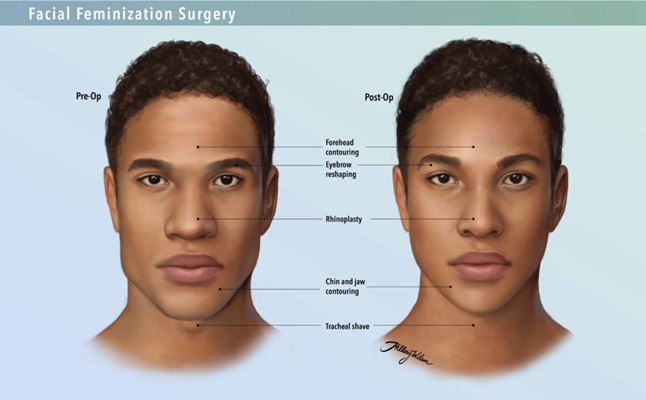Facial Feminization Surgery (FFS)
Featured Expert:
Facial feminization surgery, or FFS, is a series of plastic surgery procedures designed to create a more feminine appearance of the face for patients undergoing gender affirmation treatment.
What You Need to Know
- Facial feminization surgery may be part of the treatment approach for a person who desires a more feminine facial appearance.
- FFS usually does not happen in one operation. Instead, a staged approach, based on your priorities, is recommended.
- FFS procedures can reshape the forehead, brows, nose, cheeks and jaw as well as minimize the appearance of an Adam’s apple (tracheal shave).
- In addition to plastic surgery, facial feminization procedures include nonsurgical treatments such as cosmetic fillers, botulinum toxin, fat grafting and liposuction.
What is FFS?
Facial feminization surgery is a series of procedures that can reshape the face and its features to achieve a more feminine appearance. For people in whom hormone therapy is not enough to achieve desired gender-affirming changes to the face, surgery can help.
Who might need facial gender surgery?
FFS may be part of an overall plan of gender affirmation, aligning the appearance of the face and body with a person’s gender. The procedures can also be appropriate for gender nonbinary people seeking a more feminine facial appearance.
FFS Procedures
Depending on your priorities, the plan you agree on with your surgeon may include one or more of the following procedures:
Forehead and Hairline Contouring
Shaping the forehead and hairline can create a more oval or heart shape to the face. A surgeon can reconstruct the forehead by thoroughly measuring the existing bone structure and carefully working around the frontal sinuses behind the bone of your forehead.
The procedure may include reducing the prominence of the bony ridge above your eyes and reshaping the hairline. The surgeon may simply shave or grind down the bony ridge or cut a piece of existing bone (osteotomy) and replace it with a bone graft with a smoother surface. Cutting and reformatting the scalp can lower the hairline and give it a more feminine or nonbinary look.
Forehead reconstruction requires an incision that goes across your head from ear to ear. At the end of the procedure, the incision will be closed with sutures that do not need to be removed. When you awaken from surgery, there will be a drain in place; this will likely come out before you are released to go home.
Brow Lift and Eyelid Lift
The brow may be elevated to give the eyes a feminine appearance. For patients having forehead and hairline contouring, the brow can be lifted through the same incision made in the scalp. For patients who are only having a brow lift, the surgeon can make four or five small, one-centimeter incisions in the hairline or an incision around the brow line.
In older patients, the eyelids may also be lifted to open the eyes and achieve a more feminine look. The incisions for an eyelid lift can either be hidden in the crease of the eyelid or placed behind it to minimize visible incisions.
Nose Surgery for Facial Feminization
The surgeon can perform a nose-reshaping operation called a rhinoplasty (sometimes called a nose job) to reduce the width and shape of the nose. The procedure can involve cutting or reshaping the bones as well as the cartilage. A rhinoplasty can also shape the bridge and the tip of the nose to give them a more delicate appearance.
Jaw Contouring and Chin Reduction
In preparation for facial feminization surgery of the jaw and chin, the surgeon may request an evaluation by a dentist or orthodontist to ensure your teeth and jaw bones are healthy and that you do not have any infected teeth, cavities or third molars (wisdom teeth) that have not yet emerged or been extracted.
Several procedures can be recommended to revise the contours of the jaw and chin:
- Mandibular angle recontouring by cutting or shaving the corner of the lower jaw can create a softer angle between the ear and the chin.
- Genioplasty in which the chin bone is cut and pushed forward, which may be an alternative to a chin implant. The bone of the chin may be shaved or trimmed to a less prominent, pointed or oval shape.
FFS jaw surgery requires making an incision inside the mouth, which will be closed with dissolvable stitches. You will have to clean the inside of your mouth with a prescription mouthwash for a few weeks after surgery.
After Jaw or Chin Surgery for Facial Feminization
- Your surgeon will bandage the surgical area with a special compressive dressing around your jaw, which will remain in place for a few weeks after surgery.
- It may be uncomfortable to talk, but it is safe to do so if you can.
- You may find it painful to chew solid food for a few days. Soft foods and nutritional shakes may be easier to manage.
- Avoid hot beverages for one or two weeks or until your incisions heal.
Tracheal Shave
A surgical procedure called a chondrolaryngoplasty, or tracheal shave, can reduce the size of an Adam’s apple and create a smoother neck profile. The Adam’s apple is an area of cartilage around the larynx (voice box) that tends to be larger in people assigned male at birth.
What Happens During Tracheal Shave
- The procedure takes one to two hours and may not require admission to the hospital.
- While the surgery takes place, you will be asleep under general anesthesia.
- To access the larynx, the surgeon makes an incision in your neck. The surgeon will attempt to minimize the appearance of the scar by placing it in a less obvious area or within the natural skin folds of the neck.
- The surgeon shaves away some of the cartilage from the front of the larynx to make it smaller and less prominent.
- The incision is closed with sutures (stitches).
Risks and Complications of Tracheal Shave
Some people who undergo this procedure experience side effects, most of which resolve in about a week, such as:
- Swelling or bruising
- Difficult or painful swallowing
- Muscle spasms of the vocal cords
- Hoarseness or changes to the voice
Complications can include:
- An Adam’s apple that is still prominent after the procedure
- Removal of too much cartilage, which can damage the vocal cords
- Scarring
Recovering from a Tracheal Shave Procedure
- Recovery from the procedure takes about one month. It is important to follow the doctor’s advice for the weeks following a tracheal shave.
- You will be advised to rest for a couple of days.
- You may experience some throat pain or discomfort. The doctor may recommend a soft or liquid diet until you can swallow food comfortably.

Medical Director for the Center for Transgender and Gender Expansive Health Dr. Fan Liang answers frequently asked questions on facial feminization surgery.
Liposuction and Fat Grafting
To shape the facial contours, the surgeon may recommend a procedure to remove a small amount of fat from one part of the body and use it to add volume and smooth out hollowed or sunken areas. The surgeon may use this method to shape various areas of the face and may include a silicone implant to sculpt the cheeks into a rounder, more feminine shape. These techniques are tailored to fit the goals of each individual.
Nonsurgical Procedures for Facial Gender Affirmation
- Injectables and fillers can be used for lip augmentation or to shape the contours around the mouth or eyes. The fillers usually last from six months to a year; some last longer, and patients will need to return for more filler after it dissolves.
- Hair removal with laser or electrolysis
- Skin resurfacing
- Voice therapy
- Feminizing makeup
First Assessment for FFS
Before the first consultation, the surgeon may schedule photographs, X-rays and a 3D CT scan that shows your facial bones and soft tissue. These images help the surgeon plan your surgeries and provide a baseline for evaluating results after your procedures are finished.
Preparing for Facial Feminization Surgery
Using a highly individualized approach, the plastic surgery team works with the patient to develop a plan that best meets the individual’s needs and preferences.
When multiple surgeries are desired, the surgeon will plan a staged approach. Staging surgery is safer than attempting to perform too many procedures at the same time, which can keep you under anesthesia for a prolonged period. In addition, staging provides ample time for recovery between operations.
During Your FFS Procedure
How long it takes: This depends on what you are having done. Administering cosmetic fillers may take an hour or less, while complex facial surgery may take several hours.
Staying in the hospital: Your procedure may be performed in a hospital or outpatient center. Most facial plastic surgeries involve a day or so in the hospital for observation and to ensure you are healing properly before you are released to go home.
First clinical follow-up: This usually occurs within five days of surgery, and will be scheduled before you leave.
FFS Recovery
The course of recovery for the different procedures can vary, and it can be influenced by your general state of health and your self-care after surgery.
Though the procedures are largely safe, it is important to call your doctor right away if you develop a fever, severe pain or other signs of infection, or if you have any other concerns. Here are some basics for recovery after facial surgery:
Bruising and swelling: These are common side effects after facial plastic surgery. Bruises, including black eyes, may take four to six weeks to clear up.
Pain and discomfort: Most people experience some discomfort for four or five days after surgery, but this should begin to ease, allowing you to gradually return to normal activities. Your doctor will provide instructions on returning to work and exercise and other tips on what’s safe to do and when. You may have temporary restrictions on heavy lifting, vigorous exercise or other activities.
Bandages and dressings: Do not remove tape, gauze, drains, splints or compression dressings: The doctor will take off these items and examine the surgical area at your first clinical appointment after your procedure.
Bathing and showering: Avoid showering, and gently sponge bathe instead until you return for your first post-surgery appointment and your doctor says it is OK to resume showering. When bathing or showering, be sure to use unscented soap, and never allow the water to directly spray the surgical area. Do not shave or use hair-removal processes such as waxing until your doctor clears you to resume these practices.
The Center for Transgender and Gender Expansive Health Team at Johns Hopkins
Embracing diversity and inclusion, the Center for Transgender and Gender Expansive Health provides affirming, objective, person-centered care to improve health and enhance wellness; educates interdisciplinary health care professionals to provide culturally competent, evidence-based care; informs the public on transgender health issues; and advances medical knowledge by conducting biomedical research.







